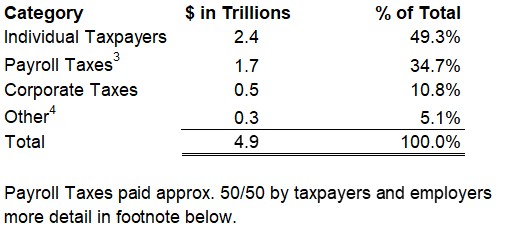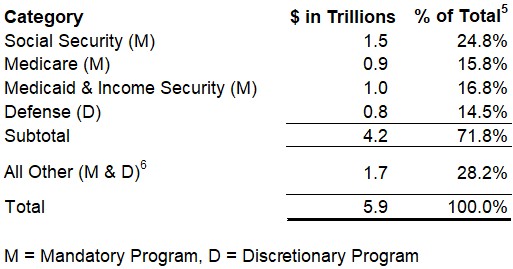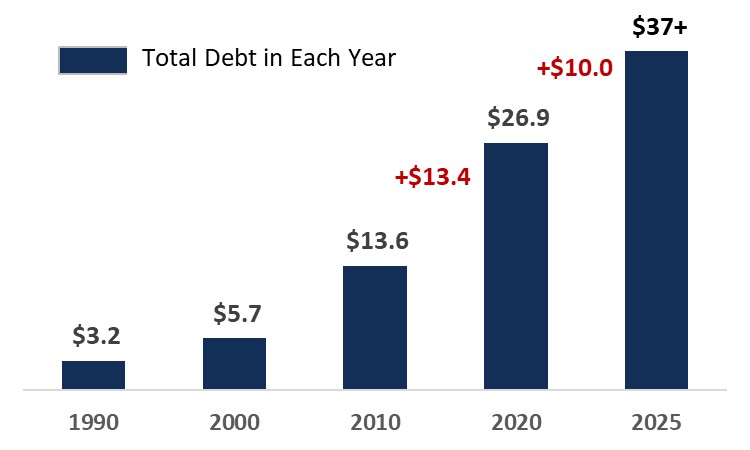In these times of extreme political divisiveness, one issue that is starting to finally get some attention is the country’s significant national debt levels. Our national debt has risen dramatically in recent years due to challenges related to the Covid pandemic, increased spending in various areas, a series of tax cuts, and the lack of willingness by politicians in both major parties to face financial realities.
As of January 2025, our total national debt stood at approximately $36T (that’s a T for Trillion). To put this in perspective, if the total debt was divided up amongst the adult population of the United States, this would equate to an approximate burden of about $140K for each adult1.
The debt has been growing at a staggering rate in recent years. In fact, total debt has doubled over the last 10 years from about $18T in 2015 to $36T in 2025. The average annual increase in the debt over that period of time was $1.8T2.
Where does the government get revenue?
Individual US taxpayers contribute the largest portion of the money that the government takes in each year, but some money also comes from corporations, and there are a few other small sources as well. The US collected a total of about $4.9T in 2024. The details are as follows below2:
2024 U.S Government Revenue

What does the government spend money on?
The government spends money in a lot of areas separated into two overarching categories: Mandatory programs (spending required by law for programs instituted by Acts of Congress) and Discretionary programs. The US spent about $6.7T in 2024. This included spending of nearly $900 billion just to pay interest on the nation’s debt. The details on the other $5.9T in spending in are as follows below2:
2024 U.S Government Spending (Excluding Interest on the Debt)

Our growing total debt
A trended view of the country’s total debt is depicted below. This shows our total cumulative debt over time from 1990-2025. The last time the government’s revenues exceeded spending was back in the year 2000. In every year since then, spending by the government has exceeded revenues, meaning that we continue to pile up more and more debt. Nearly $25T in debt has been added in just the last 15 years alone.2

2025 spending cuts
The new Trump administration has been taking aggressive actions to cut programs and departments so far in 2025. It is not clear if these actions are entirely legal, but they are occurring nonetheless. It is also not clear if this is a sincere attempt to address our ongoing annual deficits or the staggering national debt. The tax cuts granted in 2017 to individual taxpayers are set to expire at the end of 2025. The focus on spending cuts early in 2025 is expected to pave the way for extending the previously granted tax cuts well beyond 2025. It is worth nothing that Trump’s platform as a presidential candidate in 2024 did not reference the national debt or the deficit at all.
Conclusion
We are at a point in this country where we do need a sincere effort to improve the country’s financial position to keep our debt levels from spiraling out of control. Our two major political parties do not talk much about this issue as the debt is not a popular topic. An effort to improve the country’s financial situation requires a multi-faceted, rigorous, and disciplined approach. The best way to accomplish this is through a bipartisan effort (perhaps through the creation of a task force) to look at big buckets of spending and areas to perhaps increase revenue collection. A few legitimate areas that could be looked at to help address the debt situation include:
- Higher corporate tax rates and elimination of loopholes that enable companies to avoid paying their share.
- Increased capital gains taxes (targets wealthy Americans).
- Increased income tax rates for wealthy Americans.
- Reduction in the estate tax threshold. The current estate tax only comes into play for assets above $13.6 million for an individual or $27.2 million for a married couple.
- Reform of federal programs (Social Security, Medicare, etc.) to adjust eligibility ages, participation thresholds, and eliminate waste/fraud.
These suggested strategies to address the debt will be discussed in more detail in a subsequent blog post.
Notes:
- Based on total outstanding debt from the Congressional Budget Office and census data: US Census Bureau – 2020 Census count of 258.3M adults.
- From Congressional Budget Office: www.cbo.gov/publication/60870.
- Payroll Taxes includes amounts collected to fund Social Security and Medicare (the employee and employer both share equally in this cost that totals 15.3% of pay. Self-employed individuals pay the total that is normally split between employees and employers for these taxes. There is also a small federal unemployment tax that is paid entirely by employers.
- Other includes amounts collected for Excise Taxes, Estate and Gift Taxes, Customs Duties, and other miscellaneous receipts.
- Represents amounts excluding interest payments on the national debt.
- All Other includes: (1) Other Mandated programs (Children’s Health Insurance Program, spending to subsidize health insurance purchased through the marketplaces established under the Affordable Care Act, and other programs), and (2) Other Discretionary Programs (Transportation, Veteran’s Benefits and Services, Health, Education, International Affairs, General Government, Administration of Justice, Natural Resources and Environment, Housing Assistance, General Science, Space and Technology, Community and Regional Development, and Training, Employment, and Social Services spending.)
